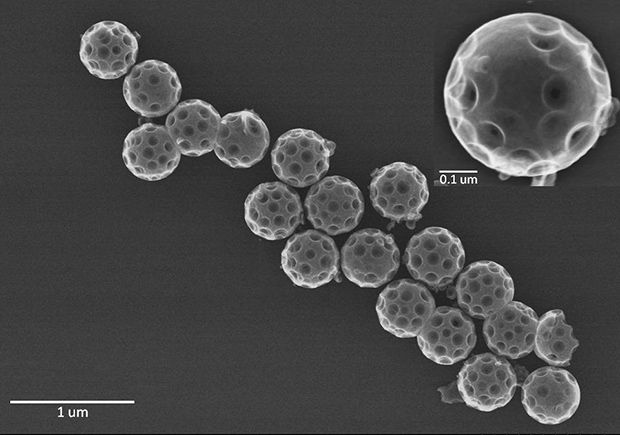
UC San Diego Graduate Student Wins Inventors Competition
By:
- Daniel Kane
Published Date
By:
- Daniel Kane
Share This:
Article Content
For work toward a safer approach to treating cancer, electrical engineering Ph.D. student Inanc Ortac from the University of California, San Diego has won first prize in the graduate student category at the 2012 Collegiate Inventors Competition.
Ortac’s winning entry, entitled “Nano-Wiffle-Balls for Cancer Therapy” offers a new approach for delivering cancer drugs just to the areas where the drugs are needed. This kind of targeted drug delivery minimizes collateral damage to non-cancerous cells.
“With our nano-wiffle-ball technology, we expect that the lethal side effects to chemotherapy can be greatly reduced, the efficacy of the therapy can be increased, and the quality of life of patients can be improved,” said Ortac.
Preclinical trials for a number of cancer types including colorectal cancer, pancreatic cancer, acute lymphoblastic leukemia, and metastatic breast cancer are under way and clinical studies will follow, according to Ortac. He plans to bring the technology to market through DevaCell Inc, a company he co-founded with his advisor, UC San Diego professor Sadik Esener and Jacobs School of Engineering alumnus Gokce Abe Yayla (Ph.D. 1996 in Electrical Engineering).
Esener is affiliated with the Departments of NanoEngineering and Electrical and Computer Engineering and at the Jacobs School of Engineering as well as the UCSD Moores Cancer Center. He is also a co-director of the Center for Nano Medicine and Engineering at the UCSD’s Institute of Engineering in Medicine (IEM).
Nano-Wiffle-Ball Therapy

Scanning electron microscope images of nano-wiffle-balls for targeted delivery of cancer therapies. Image Credit: Inanc Ortac, Ph.D. student in electrical engineering.
The nano-wiffle-ball approach can be applied for the treatment of solid and liquid tumors as well as metastatic cancers. For solid tumors the nano-wiffle-balls, which are nano-scale mesoporous capsules made of silica, are first filled with foreign enzymes and the mesopores are sealed. The nano-wiffle-balls encapsulate the enzymes and effectively hide them from the body’s immune system.
Trillions of nano-wiffle balls loaded with foreign enzymes can be directly injected near the tumor site or would be delivered systemically travelling through the blood stream and accumulate at the cancer sites. This accumulation at cancer sites occurs, in large part, due to enhanced permeability and retention effects caused by the incomplete, and therefore leaky, nature of the vasculature around tumor tissue.
Next, a non-toxic, inactive drug precursor, called a “prodrug” is administered systemically through the body. When the prodrug comes into contact with the nano-wiffle balls, the prodrug small molecule enters these nanocapsules and reacts with the enzyme cargo. These reactions activate the prodrug, turning it into an active cancer-fighting drug. In this way, the drugs are delivered just to the cancer sites where the nano-wiffle-balls accumulate.
One of the unique, and potentially valuable, aspects of the nano-wiffle-ball approach is that the enzymes that are encapsulated within these nano-balls are of foreign origin, from bacteria, for example. The prodrug is designed to react only with these foreign enzymes, eliminating the potential for the unwanted activation of the drug elsewhere in the body. This application is being investigated in collaboration with Prof. Roger Tsien’s laboratory at the UCSD Skaggs School of Pharmacy and Pharmaceutical Sciences.
Using foreign enzymes, however, means that they are likely to provoke an immune system response aimed at neutralizing and removing the enzymes from the body. To avoid this immune response, the researchers encapsulate the foreign enzymes within the nano-wiffle balls in order to hide the enzymes. In addition, nano-wiffle-balls offer low toxicity, high loading capacity, and significant control in their physical parameters. The researchers’ approach also enables easy functionalization of the nano-wiffle-balls for targeting without interfering with the activity of the cargo. Nano-wiffle-balls can be modified with molecular agents to improve the targeting and retention at the tumor site. “With application-specific modifications, this technology can potentially be applied 90% of cancer” says Ortac.
“One of the exciting application of nano-wiffle-balls technology is their use to deplete tumor nutrients, which will make them particularly useful for blood cancers and certain solid tumors” said Esener. This application of nano-wiffle-balls is being investigated jointly with the UCSD Moores Cancer Center laboratories that are conducting leukemia clinical trials under Professors Donald Durden and Thomas Kipps, and Project Scientist Bradley Messmer. Another application is in HIV related cancers, which the team is investigating with Professor Y-T Liu at the Moores Cancer Center.
The nano-wiffle ball approach could potentially be applied to other diseases and to biosensing and industrial applications, Ortac said, noting that the nano-wiffle-balls are approximately 1/1000th of the thickness of a human hair.
During his time at the Jacobs School of Engineering, Ortac has been no stranger to the process of technology commercialization. In 2011, Ortac, Ahmet Erten (Ph.D. 2010 in Electrical Engineering) and Corbin Clawson (Ph.D. 2011 in Bioengineering), won second place in the UCSD Entrepreneurship Challenge for their work on a hand-held device that will quickly screen a blood sample for methicillin-resistant Staphylococcus aureus, or MRSA, a hard-to-kill infection.
“The priceless guidance I have received from the von Liebig Entrepreneurism Center about the process of translating technologies from lab to market will follow me throughout my career,” said Ortac.
Ortac met with Prof John Holdren, the Director of the Office of Science and Technology Policy and Todd Park, the U.S. Chief Technology Officer, together with other finalists at the Eisenhower Executive Building at the White House. Holdren congratulated the winners and explained that improving cancer therapy, reducing the lethal side effects of chemotherapy and improving the quality of life of cancer patients are among the top priorities of Obama’s policy on medical research. He added that he would personally closely follow the progress of this research and report to President Obama.
Share This:
You May Also Like
Stay in the Know
Keep up with all the latest from UC San Diego. Subscribe to the newsletter today.


